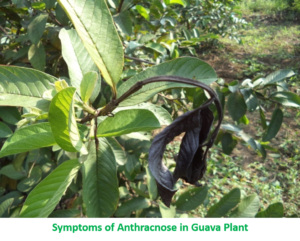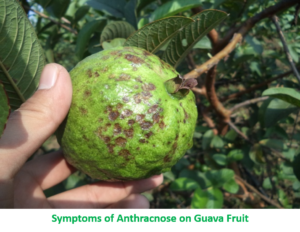< Back to Pest & Disease Management
Anthracnose is a common disease in guava orchard, caused by fungus – Gloeosporium psidii.
Symptoms:
-
On twigs: The plant begins to die backwards from the top of a branch. The greenish colour of the growing tip changes to dark brown and later to black necrotic area extending backwards causing the die back. The fungus develops from the infected twigs and then petiole and young leaves. These may droop down or fall leaving the dried twigs without leaves. The disease appears in epidemic form, during August to September (warm and humid).
-
On Fruits: Fruit and leaf infection is generally seen in rainy season crop. Pin-head spots are first seen on unripe fruits, which gradually enlarge. Spots are dark brown in colour, sunken, circular and have minute black stromata in the centre of the lesion, which produce creamy spore masses in moist weather. Several spots coalesce to form bigger lesions. The infected area on unripe fruits become corky and hardy, and often develops cracks in case of severe infection. Unopened buds and flowers are also affected by disease which caused their shedding. On leaves, the fungus causes necrotic lesions at the tip or on the margin. These lesions are usually ashy grey and bear fruiting bodies of fungus.
Mode of spread:
- By wind borne spores available on dead leaves, twigs and mumified fruits in the orchard.
- Dense canopy is congenial for germination of spores due to suitable moisture regime.
Reasons for severity:
- Closer planting without canopy management
- Leaving fruits and leaves on ground after thinning, pruning or harvesting.
- Dew or rains encourage spore production and its dispersal around canopy.
- Lack of timely application of control measures.
Management:
- Spray of Bordeaux mixture (3:3:50) or Copper oxychloride (3gms per litre) just after initiation of disease.
- Bagging of fruits when they are ber sized (50 days after flowering).
- 3 preventive sprays of fungicide and insecticide before bagging.
- Removal of all infected leaves, fruits and branches from orchard.










